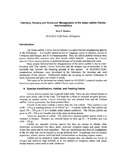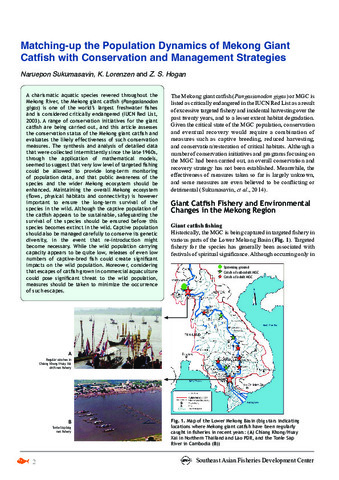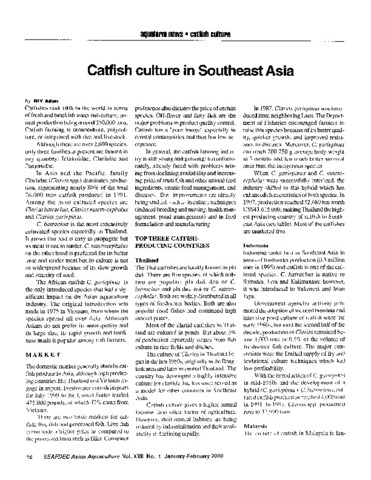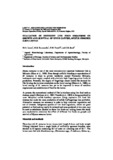Hatchery, nursery and grow-out management of the Asian catfish Clarias macrocephalus
Share
Abstract
The Asian catfish, Clarias macrocephalus is a native but fast disappearing species in the Philippines. It is locally named as hito to Tagalogs, paltat to Ilocanos, pantat to Cebuanos and Ilongos, and Ito to Pampangueños. They are called catfishes because they posses whisker-like structure near their mouth called barbells. Among the Clarias species Clarias macrocephalus is preferred because of its tender and delicious meat.
Many people believed that the disappearance of the native catfish is due to interbreeding with Thai catfish, Clarias batrachus and the rampant use of pesticides in the ricefields that "poison" the breeding grounds of this species. At SEAFDEC/AQD, standardized techniques were developed in the laboratory for breeding and seed production of this species. Verification studies are on going on nursery techniques in tanks and ponds and grow out culture in ponds.
The topics to be discussed are mostly based on SEAFDEC's research studies and hands-on experiences on the native catfish Clarias macrocephalus.
Suggested Citation
Bombeo, R. F. (2001). Hatchery, nursery and grow-out management of the Asian catfish Clarias macrocephalus. In Fishlink 2001, 29-31 May 2001 (8 pp). Iloilo City, Philippines: University of the Philippines Aquaculture Society, Inc.
Subject
Collections
Related items
Showing items related by title, author, creator and subject.
-
Matching-up the population dynamics of mekong giant catfish with conservation and management strategies
Sukumasavin, Naruepon; Lorenzen, K.; Hogan, Z. S. (Secretariat, Southeast Asian Fisheries Development Center, 2015)A charismatic aquatic species revered throughout the Mekong River, the Mekong giant catfish (Pangasianodon gigas) is one of the world's largest freshwater fishes and is considered critically endangered (IUCN Red List, ... -
Catfish culture in Southeast Asia
Adan, R. I. Y. (Aquaculture Department, Southeast Asian Fisheries Development Center, 2000)Catfish rank fifth in the world in terms of fresh and brackishwater fish culture. In Asia and the Pacific, the Clariidae family dominates production, representing nearly 80% of the total catfish production. Among the most ... -
Evaluation of different live food organisms on growth and survival of river catfish, Mystus nemurus (C&V) larvae
Laron, M. A.; Kamarudin, M. S.; Yusoff, F. M.; Saad, C.R. (European Aquaculture Society, 2001)Mystus nemurus is one of the most commercially important freshwater fish in Malaysia. Even though artificial breeding or reproduction of M. nemurus is done in private hatcheries around Peninsular Malaysia, inadequate seed ...




